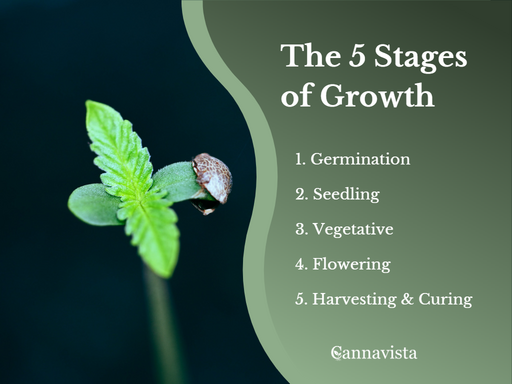
High Five
A Scientific Journey through the 5 Stages of Cannabis Growth
Are you a budding cannabis enthusiast looking to learn more about the science behind your favorite plant? Look no further than the five stages of growth for the cannabis plant, each with its own unique set of challenges and rewards. From the germination stage to harvesting and curing, we'll take you on a journey through the science of cannabis growth, with a touch of humor to keep things interesting. So sit back, light up your favorite strain, and let's dive into the five stages of cannabis growth.
Stage 1: Germination - The Birth of a Cannabis Plant
The first stage of growth for the cannabis plant is germination, the process of bringing the seed to life. This is where the magic happens, as the seed sprouts and develops a taproot that will anchor the plant in the soil. But how does it all work?
When a cannabis seed is planted in soil or a growing medium, it absorbs moisture and begins to swell. The seed coat cracks open, and a small root emerges from the tip of the seed. This root is known as the radicle, and it's the first sign that the seed is germinating. As the root grows, it pushes the seedling up through the soil and towards the light.
But how do we ensure successful germination? The key is to provide the seed with the right amount of moisture and warmth. The ideal temperature range for germination is between 68-70°F (20-21°C), and the seed should be kept moist but not waterlogged. Once the taproot has developed, the seedling will emerge from the soil, and the first set of leaves, known as cotyledons, will appear.
One easy way to germinate cannabis seedlings before planting them in soil or growing medium is by using the paper towel method. Simply dampen a paper towel, place your cannabis seeds on it, and fold the towel over so that the seeds are sandwiched in between. Place the towel in a plastic bag and keep it in a warm, dark place for a few days until the seeds sprout. Once the seeds have germinated, you can carefully transfer them to your grow media. This method is simple, cost-effective, and doesn't require any specialized equipment.
Stage 2: Seedling - Watch Your Little One Grow
Now that our cannabis plant has sprouted, it's time for the next stage of growth: the seedling stage. This is where the plant begins to develop its true leaves and grow rapidly. But it's a delicate time for the plant, and it requires a lot of care and attention.
During this stage, the plant requires a lot of light, but care must be taken to avoid burning the delicate leaves. The ideal light cycle for seedlings is around 18 hours of light and 6 hours of darkness, with a temperature range of 70-75°F (21-24°C) and a relative humidity of around 60%. It's also important to provide the plant with the right nutrients to support its growth, with higher levels of nitrogen and lower levels of phosphorus and potassium.
But be warned: seedlings are fragile little creatures, and even the slightest mistake can have disastrous consequences. Overwatering can cause root rot, while underwatering can cause the plant to wilt and die. It's a delicate balancing act, but with a little love and care, your little seedling will grow into a healthy, strong plant.
Stage 3: Vegetative - Let's Get Growing
Our cannabis plant has now entered the vegetative stage, where it will continue to grow rapidly and develop a strong root system and thick branches. This is where things really start to get exciting, as the plant begins to take on a more recognizable form.
During this stage, the plant will require more light and nutrients than in the seedling stage, with a light cycle of around 18 hours of light and 6 hours of darkness. The temperature range should be maintained at around 70-80°F (21-27°C), with a relative humidity of around 50%. It's important to monitor the plant's nutrient levels carefully during this stage, as imbalances can cause stunted growth or other problems.
But the vegetative stage isn't just about growing bigger, it's also about shaping the plant to prepare for the flowering stage. This is where pruning and training techniques can be used to promote bushy, productive growth. Techniques like topping, where the top of the plant is removed to encourage branching, and low-stress training, where the branches are bent and tied down to create a more even canopy, can be used to shape the plant to your liking.
It's also important to be on the lookout for any signs of pest or disease during this stage, as the plant is still vulnerable to attack. Common pests like spider mites and aphids can be controlled with natural remedies like neem oil or ladybugs, while diseases like powdery mildew can be prevented by maintaining good air circulation and avoiding excess humidity.
Stage 4: Flowering - It's All About the Buds
The flowering stage is where things really start to get interesting, as our cannabis plant shifts its focus from growth to reproduction. This is where the plant will develop its buds, which contain the coveted cannabinoids and terpenes that give cannabis its unique effects and flavors.
During this stage, the plant will require a different light cycle to trigger the flowering process. Most cannabis strains require a light cycle of 12 hours of light and 12 hours of darkness to begin flowering, with a temperature range of around 65-80°F (18-27°C) and a relative humidity of around 40-50%. It's important to maintain good air circulation and avoid excess humidity during this stage, as moisture can lead to bud rot and other problems.
It's also important to provide the plant with the right nutrients during the flowering stage, with lower levels of nitrogen and higher levels of phosphorus and potassium to support bud development. Many growers also use supplements like molasses or bloom boosters to enhance flavor and aroma.
I lied, the flowering stage isn't just about the buds; it's also about patience. Most cannabis strains take around 8-12 weeks to reach full maturity, with some taking even longer. It can be tempting to harvest early to get a quick taste of the goods, but waiting until the buds are fully ripe will result in a more potent and flavorful product.
Stage 5: Harvest and Curing - The Fruits of Our Labor
Congratulations, we've made it to the final stage of growth for our cannabis plant: harvest and curing. This is where we get to enjoy the fruits of our labor, as we harvest and dry our buds to perfection.
Harvesting can be a delicate process, as the buds must be handled with care to avoid damaging the delicate trichomes that contain the cannabinoids and terpenes. Most growers prefer to harvest by cutting the branches and hanging them upside down to dry in a dark, cool place with good air circulation. Once the buds are dry, they can be trimmed and cured in glass jars to enhance flavor and aroma.
Curing is a crucial step in the process, as it allows the buds to develop a smoother, more flavorful smoke. To cure your buds, simply place them in glass jars and open them once a day to let out excess moisture. After a few weeks of curing, your buds will be ready to enjoy.
So there you have it, the five stages of growth for the cannabis plant. From the birth of a tiny seedling to the harvest of flavorful, potent buds, it's a journey filled with challenges and rewards. Whether you're a seasoned grower or just starting out, understanding the science behind cannabis growth is key to producing high-quality buds. So get growing, and remember to have fun along the way!
No posts found
Write a review
